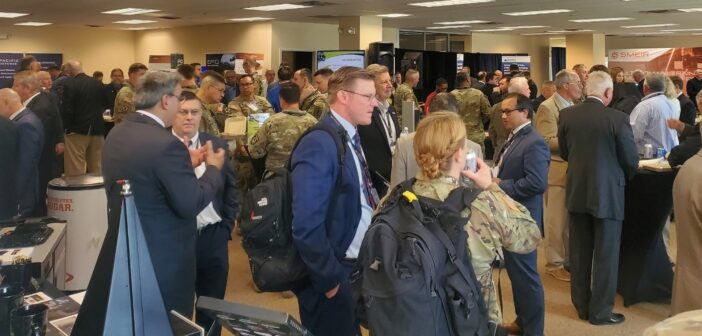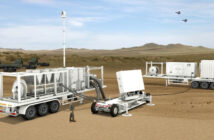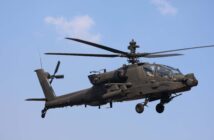On May 3-4, the Association of Old Crows (AOC) hosted its annual Cyber Electromagnetic Activity (CEMA) Conference, in collaboration with the local AOC APG Susquehanna Chapter. This signature AOC conference dives deep into the US Army’s plans to field an integrated electromagnetic warfare (EW), signals intelligence (SIGINT), and Cyber capabilities for EMS and Cyberspace superiority.
EMS superiority is the backbone to mission success across all warfighting domains. It is the only maneuver space we can substantially affect by 2027. This perspective permeated briefings throughout the conference adhering to the theme, “The Invisible Battlefield: Deterrence During Competition, Dominance Throughout the Conflict.” These interdependent objectives highlight the fact that the invisible, complex, and congested electromagnetic spectrum is today where battles are won or lost. There is no more “down the road” perspectives, only today’s imperative for EMS Superiority.
The Army should be applauded for its comprehensive organizational approach to EMS and Cyberspace superiority. It has long advocated for driving decision-making and maneuverability down to the division and supporting the warfighter with technologically agile and digitally-driven capabilities to maneuver and “always on” EMS and Cyber environment anywhere around the world.
The first day of CEMA featured a keynote address by Mr. Joseph Welch, SES, Director of DEVCOM C5ISR, and several presentations focusing on network resiliency, the role of artificial intelligence (AI) and machine learning (ML), the integration of AI/ML in future into multi-function systems. Specifically, Mr. Welch discussed the trend toward “Intelligent EW” – moving from legacy coordinated EW systems to collaborative systems, to intelligent systems that provide predictive actions, adaptive EA, distributed electromagnetic support and attack, anticipatory response to agile threats, and quantum sensing. Brigadier General Jeth Ray, Director of the Network Cross Functional Team (CFT) focused his remarks on the need to invest in network resiliency that underpins all Army modernization efforts. As we’ve seen with Russia’s invasion of Ukraine, an adversary will seek to draw the fight into the most complex EMS environment, making resiliency paramount for network connectivity.
Attendees also heard from Dr. Andrew Portune, Senior Research Scientist at Peraton Labs, the Title Sponsor of the CEMA 2022. He discussed AI/ML-based orchestration of multi-function CEMA systems at the tactical edge. According to Dr. Portune, MDO applications of CMOSS or other open architecture multi-function platforms are reliant upon adaptive and effective management of modular payload capabilities. Thus, increased payload flexibility and capability poses significant orchestration challenges. A Peraton solution is BRAHMS – Balanced RF Resource Allocator for Heterogeneous Multi Objective Systems. BRAHMS provides a multifunction RF platform manager that coordinates RF mission goals in spectrum, space, and time. This scalable system leverages sophisticated artificial intelligence (AI) and machine learning (ML), optimizes resource allocations, dynamically adjusts to changes in environment and unexpected conditions, and delivers superior performance for real time resource management on modular RF systems supporting communications, EW, and radar. BRAHMS is just one example of key solutions brought to CEMA 2022 to address the myriad challenges that the US Army faces in implementing its CEMA vision.
Day 2 looked more closely at EW programs and capabilities, specifically. A keynote address by Mr. Mark Kitz, SES, PEO Intelligence, Electronic Warfare and Sensors (IEW&S) was followed by presentations from Defense Information Systems Agency (DISA), US Army Cyber School, Army Futures Command, DAMO-SO and other industry partner solutions. Mr. Nucci directly discussed the imperative that the US Army must transform its warfighting capabilities to become a technologically agile and digitally driven Army. The reality is that while we look to 2030 and beyond in broad strategic terms, global security today suggests we will likely need to call upon many of the innovations discussed at CEMA sooner than planned or anticipated. Mr. Nucci continued, “We must innovate and modernize at speed and scale, immediately improving our current capabilities and posturing the Army for the future. It is more important than ever to hold innovation and modernization as top priorities for our Army. It is vital for our force to evolve at a pace faster than current and future adversaries. Transformation and convergence are foundational elements that will require organizations to integrate across mission areas, warfighting functions and get to integrated mission command based on a data centric unified network to maximizing operational value.”
Mr. Ken Strayer, Project Manager for EW and Cyber at PEO IEWS reinforced this call to action by laying out present-to-future program funding priorities and expectations to equip the Army for Multi-Domain Operations. This includes continued investment in the EW Planning and Management Tool (EW PMT), Multi-Function EW-Air Large (MFEW-AL), an airborne EW pod employed on Army manned or unmanned aircraft systems, and the Terrestrial Layer System – Brigade Combat Team (TLS-BCT) and Echelons Above Brigade (TLS-EAB), a next generation tactical vehicle based system that delivers an integrated suite of SIGINT, EW, & Cyberspace Operations overmatch capabilities to enable Joint All-Domain Operations. Mr. Strayer also highlighted emerging requirements, including CMOSS Mounted Form Factor EW Payload, Modular Electromagnetic Suite of Systems (MEMSS), and Tactical Aerial EW System (TAEWS) / Air-Launched Effects (ALE).
The US Army has a difficult task ahead to innovate, invest, develop, deliver, and modernize its force for Cyber and EMS superiority required for mission success today. It is critical that Army leadership and all senior stakeholders collaboratively embrace the tough decisions that must be made to ensure its CEMA vision is implemented with the urgency that the global security environment dictates today. The AOC will continue to engage throughout the EMS community to advocate, educate and connect to ensure all warfighters who use and operate within the EMS have the capabilities and knowledge to do so throughout the coming years.






